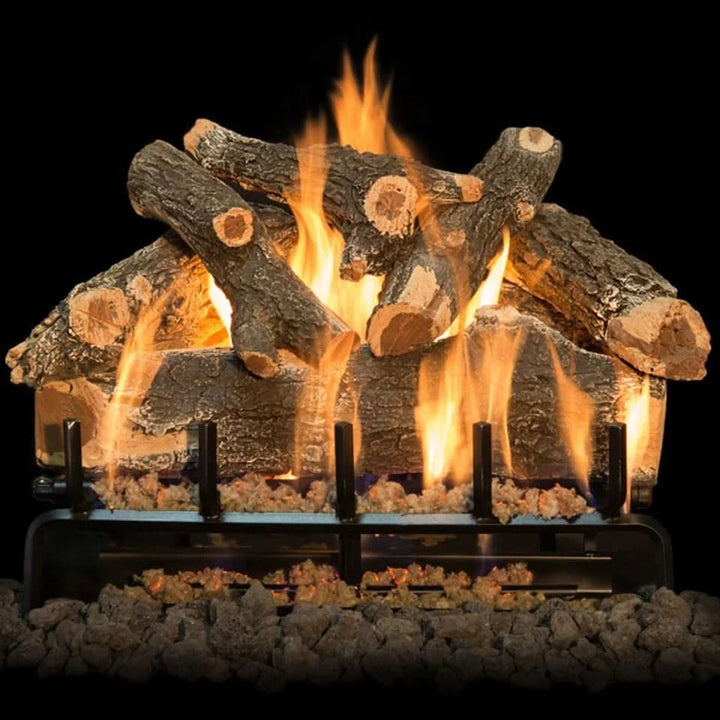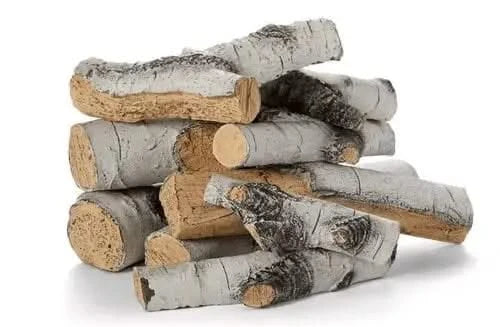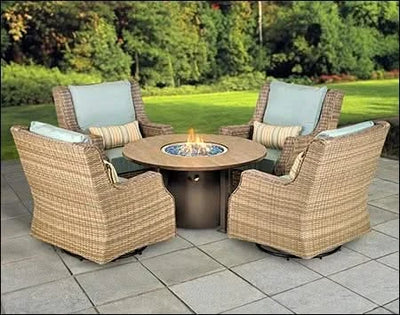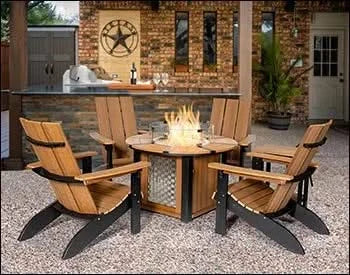As the crisp autumn air rolls in, many of us turn to our cozy outdoor fire pit tables for warmth and ambiance. However, it's crucial to be mindful of the type of wood you burn. Burning the wrong type of wood or burning rotten wood can lead to various problems, including poor fire performance, environmental damage, and even safety hazards.
Table of Contents
Can You Burn Rotten Wood in a Fire Pit?
Short answer: No, you shouldn't.
While it might seem tempting to use any wood you find, especially if you're trying to save money, burning rotten wood in your fire pit is not a good idea. Rotten wood is often damp and doesn't burn efficiently. This can lead to a lot of smoke, a weak fire, and even damage to your chimney.
Instead, opt for well-seasoned hardwood like oak or maple. These types of wood burn cleanly, produce less smoke, and provide a steady, warm flame.
So, while it might seem tempting to use that old, weathered piece of wood, it's best to stick with dry, seasoned firewood for a safe and enjoyable fire pit experience.
 Typical example of rotten wood that shouldn't be burnt in a fire pit
Typical example of rotten wood that shouldn't be burnt in a fire pitWhy Rotten Wood is a No-Go
Rotten wood is a definite no-no for your fire pit. Here's why:
- Poor Fire Performance: Rotten wood is often damp and has a low energy content. This makes it difficult to ignite and maintain a steady flame.
- Excessive Smoke: Burning rotten wood produces a significant amount of smoke, which can irritate your eyes and lungs.
- Creosote Buildup: Rotten wood can contribute to creosote buildup in your chimney. Creosote is a highly flammable substance that can lead to chimney fires.
 Weak fire and a lot of smoke
Weak fire and a lot of smokeOther Woods to Avoid
In addition to rotten wood, there are several other types of wood that should be avoided:
- Treated Wood: Pressure-treated wood, often used for outdoor structures, contains harmful chemicals that can release toxic fumes when burned.
- Softwoods: Softwoods like pine and cedar produce a lot of smoke and burn quickly, making them less efficient as firewood.
- Green Wood: Freshly cut wood with high moisture content burns poorly and can lead to creosote buildup.
- Driftwood: Saltwater can damage the wood and release harmful chemicals when burned.
Choosing the Right Firewood
When it comes to creating a cozy and efficient fire pit experience, the type of wood you choose plays a crucial role. Let's delve into the characteristics of different wood types and their ideal applications.
There are two primary types of firewood: hardwood and softwood.
Hardwoods, like oak, maple, and hickory, are denser and burn slower, producing less smoke. They're perfect for long, steady burns, ideal for those chilly nights.
- Oak: Known for its density and slow burn, oak provides consistent heat output.
Arizona Weathered Oak Grand Canyon Gas Logs

$271.00
Experience the breath taking detail of the Arizona Weathered Oak Grand Canyon Logs. They are suitable for both indoor and outdoor fireplaces. Each log is hand-cast from a real, lightning-struck tree, capturing unique textures and imperfections for an incredibly lifelike… read more
- Maple: Offers a balanced burn with a pleasant aroma.
- Hickory: Burns incredibly hot and fast, making it great for quick bursts of heat or cooking.
How long can you burn hardwoods in a fire pit?
How long a hardwood log burns in a fire pit depends on several factors:
- Size of the Log: Larger logs will naturally burn longer.
- Wood Species: Different hardwoods burn at different rates. Dense woods like oak tend to burn slower than less dense woods like birch.
- Moisture Content: Well-seasoned wood with low moisture content burns longer and cleaner.
- Fire Pit Size and Design: A larger fire pit can accommodate larger logs and maintain a longer-lasting fire.
- Weather Conditions: Wind and temperature can affect the burn time.
Generally, a well-seasoned hardwood log can burn for several hours. However, the exact duration will vary depending on the factors mentioned above.
Softwood Softwoods, such as pine, spruce, and fir, are less dense and burn more quickly, producing more smoke. While useful for starting a fire or adding a quick burst of heat, they're generally not as efficient as hardwoods.
- Aspen: Burns quickly and easily, making it ideal for starting a fire.
HPC Fire Aspen Birch Outdoor Fire Pit Logs 16 piece

$900.45
Bring the campfire experience to your backyard with HPC's new line of realistic, cast concrete outdoor fire pit logs. Aspen Birch fire pit logs are nearly indistinguishable from real wood, thanks to moulds created from actual firewood. Highly durable concrete… read more
- Birch: Burns hot and clean, producing a pleasant aroma.
- Ash: Burns hot and clean, providing a good, long-lasting fire.
Remember, the key to a great fire is well-seasoned wood. Ensure your wood is dry to avoid excessive smoke and inefficient burning. By understanding these wood types and their characteristics, you can choose the best fuel for your fire pit and enjoy a cozy, efficient, and safe outdoor experience.
How long can you burn Softwoods in a Fire Pit?
- Burns quickly: Softwoods like pine and spruce burn quickly, making them ideal for starting a fire or adding a burst of heat.
- Produces more smoke: Due to their resin content, softwoods tend to produce more smoke than hardwoods.
- Shorter burn time: Because they burn quickly, softwoods generally have a shorter burn time compared to hardwoods.
While softwoods can be useful for specific purposes, it's generally recommended to use them in moderation or as a starter for your fire. For a longer-lasting, cleaner burn, hardwood is the preferred choice.
How to maximize the burn time of your firewood
- Use a fire pit ring: This helps to contain the heat and direct it upwards.
 Flames are directed upwards when using a fire pit ring to burn wood
Flames are directed upwards when using a fire pit ring to burn wood- Avoid using accelerants: These can cause the wood to burn too quickly.
- Add wood gradually: Add logs as needed to maintain a steady fire.
- Cover the fire pit with a weatherproof firepit cover when not in use: This can help to protect the fire from wind and rain, which can affect the burn time.
By following these tips, you can enjoy a longer-lasting and more efficient fire pit experience.
Tips for Safe Fire Pit Use
- Build a Safe Fire Pit: Ensure your fire pit is placed on a stable, non-combustible surface and is surrounded by a protective barrier.
- Check Local Fire Restrictions: Be aware of local fire restrictions and regulations.
- Never Leave a Fire Unattended: Always supervise your fire pit and extinguish it completely before leaving.
- Keep a Fire Extinguisher Nearby: Be prepared for emergencies.
- Clean Up Properly: Dispose of ashes in a metal container and allow them to cool completely before disposing of them.
By following these guidelines and choosing the right type of firewood, you can enjoy safe and cozy evenings by your fire pit.
Frequently Asked Questions
Q: Is it okay to burn rotten firewood? A: No, it's not recommended to burn rotten firewood. It can produce excessive smoke, reduce heat output, and contribute to creosote buildup in your chimney.
Q: Can you burn moldy wood in a fire pit? A: No, you should not burn moldy wood. Mold can release harmful spores into the air, which can cause respiratory problems.
Q: What wood should you not burn in a fire pit? A: Avoid burning treated wood, softwood, green wood, driftwood, and any wood that is rotten or moldy.
Q: How to get rid of rotten firewood? A: You can dispose of rotten firewood by composting it or adding it to your garden as mulch.
By following these guidelines and being mindful of the type of wood you burn, you can enjoy a safe and enjoyable fire pit experience.







